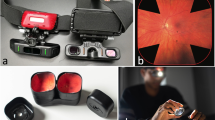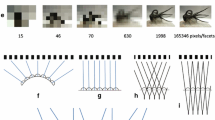Abstract
An antifogging function surface with simple structure and suitable for large-area production was found inspired by Ephemera pictiventris McLachlan compound eyes. The compound eyes structure, antifogging properties and mechanism were studied by anti-fog test, dyeing test and scanning electron microscopy, and so forth. Then, 3D model of the sample was established, and the antifogging mechanism was explained by the Cassie model. Results showed that the compound eyes are composed of hundreds of micron size ommatidia arranged in curved array form, and this structure shows excellent antifogging function. This research may provide new ideas for design of simple structure and micron size antifogging function surface. This work is also expected to be applied to antifogging function surface of astronaut helmets and medical endoscopes, and so forth.






Similar content being viewed by others
References
Liu XM, He JH (2010) Progress in antifogging technology-from surface engineering to functional Surfaces. Prog Chem 22:270–276
Ebert D, Bhushan B (2012) Transparent, superhydrophobic, and wear-resistant coatings on glass and polymer substrates using SiO2, ZnO, and ITO nanoparticles. Langmuir 28:11391–11399
Hikita M, Tanaka K, Nakamura T et al (2005) Super-liquid-repellent surfaces prepared by colloidal silica nanoparticles covered with fluoroalkyl groups. Langmuir 21:7299–7302
Nadargi DY, Kalesh RR, Rao AV (2009) Rapid reduction in gelation time and impregnation of hydrophobic property in the tetraethoxysilane (TEOS) based silica aerogels using NH4F catalyzed single step sol–gel process. J Alloys Compd 480:689–695
Ellsworth MW, Novak BM (1997) Mutually interpenetrating inorganic–orgnanic net works. New routes nonshrinking sol–gel composite materials. J Am Chem Sci 113:2756–2758
Raut NC, Mathews T, Chandramohan P et al (2011) Effect of temperature on the growth of TiO2 thin films synthesized by spray pyrolysis: structural, compositional and optical properties. Mater Res Bull 46:2057–2063
Rahimi A, Gharazi S, Ershad-Langroudi A et al (2006) Synthesis and characterization of hydrophilic nanocomposite coating on glass substrate. J Appl Polym Sci 102:5322–5329
Du X, He JH (2012) Structurally colored surfaces with antireflective, self-cleaning and antifogging properties. J Colloid Interface Sci 381:189–197
Zhang L, Lü CL, Li YF et al (2012) Fabrication of biomimetic high performance antireflective and antifogging film by spin-coating. J Colloid Interface Sci 374:89–95
Douglas AL, Baugher BM, Baugher CR et al (2000) Substituent effects on the sol–gel chemistry of organotrialkoxysilanes. Chem Mater 12:3624–3632
Tsukruk VV, Luzinov I, Julthongpiput D (1999) Sticky molecular surfaces: epoxysilane self-assembled monolayers. Langmuir 15:3029–3032
Weng WH, Song CL, Weng WJ (2008) Fast coating of TiO2 on glass by chemical vapor deposition at atmospheric pressure. Chin J Vac Sci Technol 28:16–20
Wang XP, Yu Y, Gao L (2000) Preparation of TiO2 thin films by liquid phase deposition methods and their properties. J Inorg Mater 15:573–576
Zhu L, Cui XL, Shen J (2007) Visible light photoelectron chemical response of carbon-doped TiO2 thin films prepared by DC reactive magnetron sputtering. Acta Phys Chim Sin 23:1662–1665
Yang XY, Zheng ZX, Tang WM (2007) Study on the photo-catalytic degradation of methyl orange by using titania coated fiber glass cloth. Phys Test Chem Anal Part A 43:275–278
Faustini M, Nicole L, Innocenzi P et al (2010) Hydrophobic, antireflective, self-cleaning, and antifogging sol–gel coatings: an example of multifunctional nanostructured materials for photovoltaic cells. Chem Mater 22:4406–4413
Decker C, Masson F, Schwalm R (2004) How to speed up the UV curing of water-based acrylic coatings. J Coat Technol Res 1:127–136
Cebeci FC, Wu ZZ, Zhai L et al (2006) Nanoporosity-driven superhydrophilicity: a means to create multifunctional antifogging coatings. Langmuir 22:2856–2862
Liu XM, Du X, He JH (2008) Hierarchically structured porous films of silica hollow spheres via layer-by-layer assembly and their superhydrophilic and antifogging properties. Chem Phys Chem 9:305–309
Li XY, He JH (2012) In situ assembly of raspberry and mulberry-like silica nanospheres toward antireflective and antifogging coatings. ACS Appl Mater Interfaces 4:2204–2211
Xu LG, He JH (2012) Antifogging and antireflection coatings fabricated by integrating solid and mesoporous silica nanoparticles without any post-treatments. ACS Appl Mater Interf 4:3293–3299
Liu XM, He JH (2009) Superhydrophilic and antireflective properties of silica nanoparticle coatings fabricated via layer-by-layer assembly and postcalcination. J Phys Chem C 113:148–152
Du X, Liu XM, Chen HM et al (2009) Facile fabrication of raspberry-like composite nanoparticles and their application as building blocks for constructing superhydrophilic coatings. J Phys Chem C 113:9063–9070
Zheng H P, Hazle J (2010) Process for preparing articles having antifog layer by layer coating and coated articles having enhanced antifog and durability properties. US Patent, 0 304 150A, 2 Dec 2010
Gemici Z, Rubner MF (2011) Superhydrophilic coating. US Patent, 0 073 003A, 31 Mar 2011
Liu KS, Yao X, Jiang L (2010) Recent developments in bio-inspired special wettability. Chem Soc Rev 39:3240–3255
Liu KS, Jiang L (2011) Multifunctional integration: from biological to bio-inspired materials. ACS Nano 5:6786–6790
Liu KS, Tian Y, Jiang L (2013) Bio-inspired superoleophobic and smart materials: design, fabrication, and application. Prog Mater Sci 58:503–564
Gao X, Yan X, Yao X et al (2007) The dry-style antifogging properties of mosquito compound eyes and artificial analogues prepared by soft lithography. Adv Mater 19:2213–2217
Parker AR, Lawrence CR (2001) Water capture from desert fogs by a Namibian beetle. Nature 414:33–34
Acknowledgments
This work was supported by the National Natural Science Foundation of China (51175220, 51290292, 51325501) and Jilin Science and Technology Development Project (20111808).
Author information
Authors and Affiliations
Corresponding author
About this article
Cite this article
Han, Z., Guan, H., Cao, Y. et al. Antifogging properties and mechanism of micron structure in Ephemera pictiventris McLachlan compound eyes. Chin. Sci. Bull. 59, 2039–2044 (2014). https://doi.org/10.1007/s11434-014-0252-3
Received:
Accepted:
Published:
Issue Date:
DOI: https://doi.org/10.1007/s11434-014-0252-3




